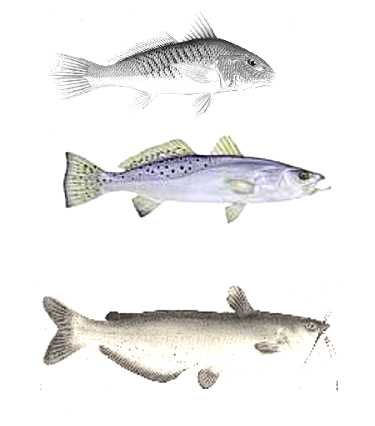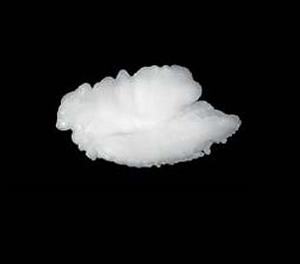Fish
Fish were the single most important protein source for the coastal inhabitants of Texas from the Early Archaic to the Late Prehistoric periods. The freshwater rivers and brackish marshlands and bays provided a rich assortment, including catfish, redfish, or red drum, black drum, and Atlantic croaker. Fish were hunted using several strategies. Larger fish were harpooned with spears or shot with bows and arrows, and smaller fish were corralled into weirs or caught with nets made from fibrous plants. Evidence of fishing technologies have been found in a number of coastal archeological sites, including fishing hooks made from bone, net plummets made of stone, and net weights made of heavy oyster shells.
Some subsistence studies suggest fish were procured seasonally during the fall and winter months when plant foodstuffs were scarce. Archeological studies have shown that many of the inhabitants of the Texas coast lived in seasonal camps. In the summer the coastal inhabitants would retreat inland and collectively gather plants such as prickly pears and blackberries, and in the winter they would disperse into small fishing camps to exploit marine food sources.
Faunal remains recovered from many sites along the Texas coast attest to the wide spectrum of fish species that were exploited by native peoples. Specifically, the rayfins—seatrout, redfish, and black drum—dominate the aquatic vertebrate assemblage. The most common remains recovered are fish vertebrae, fin spines, and otoliths. Of these, otoliths preserve the best and are useful to archeologists in building chronologies. Otoliths, small bones of the inner ear that assist fish in balance, accrete rings of calcium carbonate and bone at rates that vary with the season; therefore, otoliths can be used like dendrochronology to determine the fish's age and seasonality of exploitation within the range of a month. At both the Clear Creek Site (41GV53) on Galveston Bay and Site 41WY50 in Willacy County, spotted seatrout (Cynoscion nebulosus), the otoliths of redfish (Sciaenops ocellatus), and black drum (Pogonias cromis) were recovered in or around hearths. In addition to rayfins, catfish (Ictaluridae) and gar (Lepisosteus) were also hunted at the Clear Creek Site.
The inhabitants of the Prairies and Marshlands prepared fish in several ways. Ethnographic accounts from Gatschet note that the Karankawa Indians offered the Spanish both cooked and raw fish. In another account the Mariames of the lower Texas coast would cook fish and then leave them to season in the elements for weeks at a time. Once infested with maggots and decay, the fish were consumed with the added protein bonus. Some archeological evidence suggests fires were built atop a shell pile to cook food such as fish and deer.

|

|
